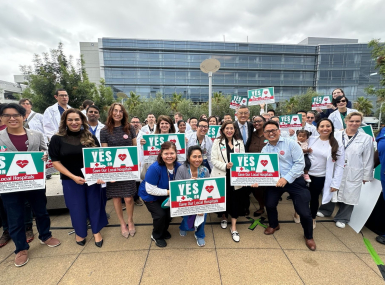State and Local Government Organizations Express Concern Over Proposed Changes to Medicaid Financing and Requirements
Upcoming Events
Related News

NACo, NLC, NCSL, USCM, CSG and ICMA emphasize the impact of policy changes to eligibility requirements and financing of Medicaid
WASHINGTON – The National Association of Counties (NACo), in partnership with a coalition of bipartisan membership organizations representing state legislators, state governments, county managers and cities today sent a letter to House and Senate leadership expressing concern over proposed changes to Medicaid financing requirements, following recent proposals that would enact significant cuts to Medicaid.
Established in 1965, Medicaid is a federal entitlement program paid for by taxpayers that provides health and long-term care insurance to low-income families and individuals. Medicaid operates and is jointly financed as a partnership between federal, state and local governments. Counties across the nation deliver Medicaid-eligible services and in many instances help states finance and administer the program.
The letter can be found here and below:
As a coalition of bipartisan membership organizations representing governors, state legislatures, cities, and counties, we are committed to working collaboratively to strengthen the Medicaid program so that states and localities can continue to meet the needs of their residents effectively. We write to express concern over proposed changes to Medicaid financing and requirements that could significantly impact state and local budgets, healthcare infrastructure, and millions of Americans who rely on the program. Medicaid is a federal-state-local partnership that provides health coverage to over 70 million Americans, including children, seniors, people with disabilities, and low-income adults. It covers 38 million children, funds 40% of all births, supports rural hospitals, and is the largest payer of long-term care and behavioral health services. Expansion has provided additional federal funding to 41 states, increasing access to care, particularly for those with substance use disorders.
Policy changes that mandate specific eligibility requirements and changes in the fiscal makeup of the program threaten Medicaid’s effectiveness and reduce state flexibility in program design. Such changes have costly implications, leading to significant coverage losses for beneficiaries and increased medical debt, with unclear long-term savings. For example, reducing the 90% federal match rate for Medicaid expansion could cut federal spending by $561 billion over nine years, forcing states to either drop expansion or absorb higher costs—jeopardizing coverage for millions and harming state economies. Likewise, proposals such as per capita caps or block grants that do not account for increases in health costs or fluctuations in enrollment would shift financial risks to states and counties. The Congressional Budget Office estimates that half of those losing Medicaid coverage under such changes would become uninsured, leading to higher medical debt, uncompensated care costs, and potential hospital closures, particularly in rural areas.
Medicaid accounts for over half of all federal funds to states and is the largest source of federal funding for state budgets, making it essential to states’ ability to design and administer healthcare programs that meet the unique needs of their populations. Preserving state flexibility and preventing significant funding cuts are both critical to ensuring Medicaid can be tailored to local priorities, as such cuts would severely limit this ability, forcing states to reduce services, restrict eligibility, or shift costs to local governments. These reductions would jeopardize access to affordable healthcare and long-term services and place an unsustainable financial burden on states and counties, which often serve as payers of last resort.
We look forward to continuing our work together as intergovernmental partners to enhance the Medicaid program and ensure that states and localities can effectively serve their residents.
For more information on Medicaid and counties, click here.
Media Contact

Nicole Weissman
Resource
Federal Reforms to Medicaid Financing: What Counties Should Know

Resource
Medicaid and Counties: Understanding the Program and Why It Matters to Counties

Related News

CMS issues new guidance on Medicaid Community Engagement Requirements
On December 8, the Centers for Medicare & Medicaid Services (CMS) released a Medicaid and CHIP Services Informational Bulletin (CIB) directing states on how to implement the Medicaid community engagement requirements enacted under Section 71119 of the One Big Beautiful Bill Act legislation (Public Law 119-21), or H.R. 1.

California county sales tax measure backfills federal healthcare cuts
Santa Clara County, Calif. will raise an estimated $330 million each year from a sales tax to backfill lose Medicaid funding.
